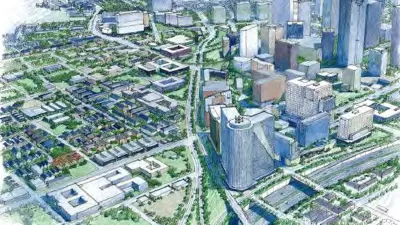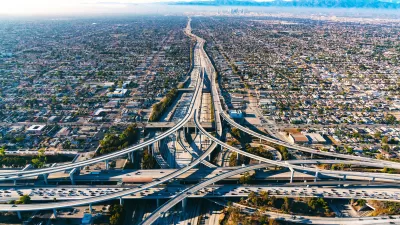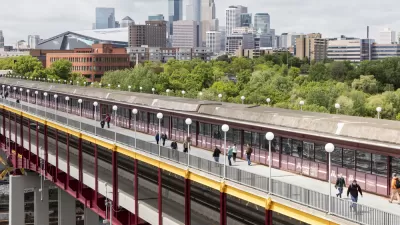Making the right decisions to create a positive urban legacy.
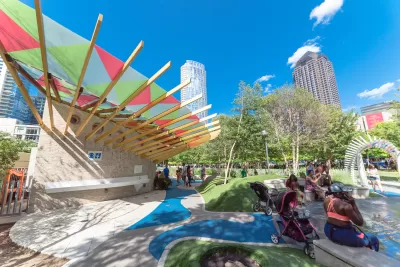
Lately, we have seen more stories in the media and statements from public officials than we ever have on the negative effects of the highways built in the last century. Those highways have often divided neighborhoods in artificial ways, making equitable planning goals difficult, if impossible to realize.
Undoing the damage done by urban highways and reknitting the fabric of America’s cities
When the highway system in the United States was built, it brought vast connectivity, wider lanes, and higher speeds. But it also did great damage to the cities it intersected. The intentional paths chosen through minority and immigrant neighborhoods caused decades of dispersion, decline, and disinvestment.
In some cities these areas have been reclaimed by investors, but in many others, the blight set in for generations. The ongoing negative physical, environmental, and social impacts of the highway system are well documented.
The good news is that municipal, state, and federal leadership are finally talking about rectifying mistakes of the past. The federal government has included funding for planning highway removal and repurposing excess roadway capacity through the passage of the recent Infrastructure Investment and Jobs Act. Included is $1 billion specifically targeted to “reconnect neighborhoods cut off by historic investments and ensure new projects increase opportunity, advance racial equity and environmental justice, and promote affordable access.” This federal funding is really a down payment toward the future by repairing our communities.
In 2021, the Congress for the New Urbanism identified 15 highways across the United States that have become functionally obsolete in their current state and are ripe for transformation report. Titled "Freeways Without Futures," this biannual report has identified dozens more potential projects since 2008. Some— particularly those along waterfronts— are recommended to be removed altogether, while others can be converted to more city-friendly boulevards.
It’s important to note that rethinking downtown highways affects more than just the immediate community. Studies such as the "Value of US Downtowns and Center Cities," co-authored by the International Downtown Association and Stantec, have revealed that when a downtown thrives, the entire economic region thrives. Addressing infrastructure issues that hinder economic development and social cohesion is something that everyone in a region will feel, not just those in the immediate neighborhood.
Successful transformation and creating safer streets
One highway that recently completed its transformation from a highway scar to a city-building boulevard is Rochester, New York’s Inner Loop East. In addition to eliminating traffic dangers, the project removed a significant barrier to redevelopment in the East End, one of Rochester’s most important downtown districts. Partially funded through federal TIGER funds and completed in 2021, the new Union Street features an at-grade parkway with improved pedestrian and cycling infrastructure.

Another New York example is the West Side Boulevard, formerly the West Side Highway (or Route 9A). The deteriorating elevated highway that bisected the west side of Manhattan was transformed into a boulevard that prioritizes pedestrians and makes space for cyclists. The benefits of removing the highway are becoming abundantly clear, years after completion of the project, with increased development, tourism, and improved public space.
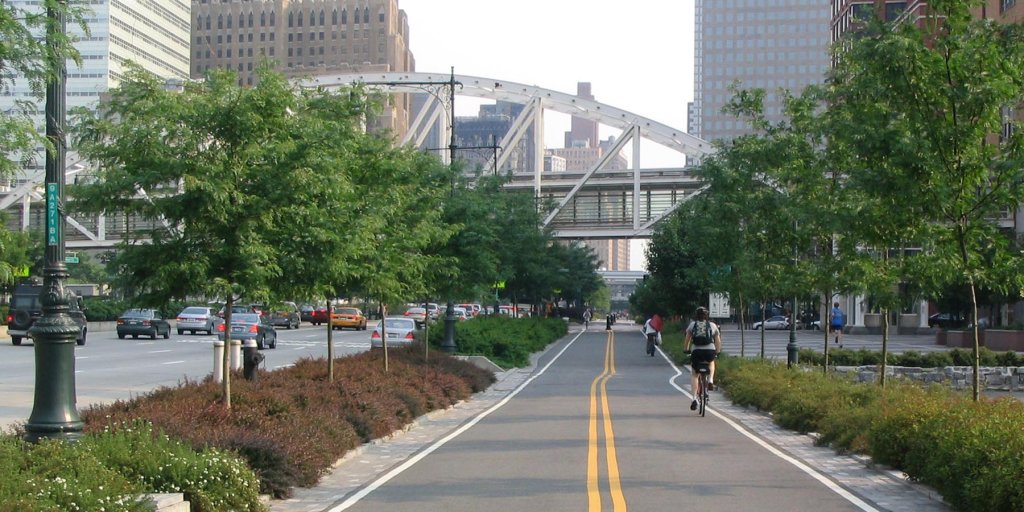
Other cities are looking to construct “caps” or “stitches,” particularly where highway removal is not an option because of existing traffic levels. This design approach eliminates the divide between neighborhoods traversed by a highway by placing a lid over the current roadway, and enhancing the lid with park space. One notable example of a cap over a rail line is in downtown Reno, Nevada, where new landscape designs and a community mural are planned to beautify the downtown.

In some cases, a full tear-down or cap isn’t the right answer. In Albany, New York, the award-winning Albany Skyway project is repurposing a little-used highway off ramp into an elevated park with high quality pedestrian and bicycle connections to the waterfront.
Building new crossings or expanding existing bridges can help reconnect communities. Wider sidewalks, lighting and even civic art can facilitate neighborhood travel on new routes. In Columbus, Ohio, the Cap at Union Station used air rights to span the bridge with continuous storefronts, making the trip on foot enjoyable and reducing road noise in the process. A community designed mural added a cultural depth to one of the additional bridges built as part of the same project.
Building new businesses to provide positive economic impact
There is a clear economic impact with these projects. In addition to creating a better corridor for the people of Rochester by stitching the downtown back together, Union Street has attracted investment worth $229 million—largely by breathing new life into existing historic buildings that were blighted by the highway.
In Charlotte, North Carolina, ten acres of residual land was made available after a reconfiguration of on- and off-ramps along I-277 to support the construction of the NASCAR Hall of Fame. This led to more than $2 billion in new construction.
The $110 million Klyde Warren Park cap over the Woodall Rogers Freeway in Dallas, Texas has generated more than $2.5 billion in economic impact. These three projects repairing highway damage had outsized net benefits, but they also represent solutions that are unique to their communities.
Equitable planning, equitable outcomes
As we plan for urban environments that prioritize environmental justice, how can planners and urban designers help communities make the right decisions for their downtowns when a highway runs right through it?
A comprehensive approach that focuses on equity at every stage of the project requires answering questions such as where projects are built, what projects are built, and how communities are engaged in the process. This means understanding the methods that have been used in the past, reviewing the results of previous studies to determine if they have led to meaningful changes, and determining areas that are still left behind and in need of more urgent investment and care.
At Stantec, we developed three strategies to promote stronger and more inclusive outcomes for projects:
Equitable Engagement: Ensure that “planning fatigue” from previous engagements is not a barrier by finding compelling and relevant activities to engage the local community. Focus groups and accessible community events are key for gathering feedback.
Equitable Prioritization: Enormous amounts of data are available that did not exist when these highways were originally planned. Choosing appropriate means and methods for collecting data – what we collect and how we choose to collect it can produce widely varied results.
Equitable Metrics: Measuring progress and developing a process for assessing change is critical for achieving inclusive project goals. What we measure and how we measure will help determine the success of the project.
Getting started and setting the project up for success
Every city can learn from recent experiences rather than beginning anew. I’ve mentioned several projects with measurable and demonstrated economic, social, and political returns for their cities.
Whether the proposed highway intervention is a cap, a stitch, a strategic intervention, or a full-removal and conversion, there are key considerations when recommending one solution over another.
- Establish community specific goals and possible alternatives.
From Rochester, New York to San Francisco, California, communities across the United States are realizing what a barrier intracity highways have become and are starting to invest in ways to repair these breaches in the civic form.
Communities have similarly lofty goals for rethinking highways: examples include improving health and safety for residents, providing economic benefits to accessible neighborhoods without displacement, and mitigating climate impacts in neighborhoods. There may be several options for solutions that re-knit a community. Working with communities to discuss what they really want is the first step.
- Listen and learn how to best serve the neighborhoods to build community support, leadership, and political will.
Of all the lessons learned thus far, the most important is a strong sense of patience. This includes recognizing that the lengthy process requires a long-term view of community investment. The replacement of less than a mile of Rochester’s Inner Loop was decades in the making and broke new ground in the national discussion.
To begin, communities need to build support for an urban planning vision. That vision should fit the needs of the community, offering options like connected networks for pedestrians and cyclists, public transit, and a quality public realm for each community.
Many freeways barreled through immigrant and minority neighborhoods, leaving the grid intact on either side but otherwise disconnecting neighbors and condemning them to a pattern of decline. A highway removal or reconfiguration project should be considered where these neighborhoods still exist and when a reconnection would aid in their resurgence.
- Consider all the design options
A new park over a freeway isn’t always the right answer. Communities can consider options including a boulevard, bridges, and park space, all with the goal of knitting communities back together.
With any major public investment comes the signal to investors that progress is occurring. Housing stability and affordability programs should go hand in hand with any such project. Arts and culture can and should be included in the planning process.
As various options are considered, it is important to prevent or mitigate gentrification and land speculation. Preserving housing affordability should be an early consideration for any project. Working with city and community leaders to establish appropriate land use around newly created street frontage that promote benefits for residents is essential.
And because once these projects lead to major construction, they will have substantial impacts on a community for a long period of time. Careful planning is required to mitigate these impacts as projects move forward.
- Leveraging the investment to create lasting value
Spending vast sums of money on these projects should always be balanced with a return on investment. Many highway corridors through the center of cities have been walled off by substantial buildings and parking structures.
As with any potential public investment strategy, it’s important to find “soft sites” where redevelopment can occur in a way that is complemented by the proposed reclamation. The conversion of a freeway to a surface street might provide places for new construction to occur on the residual land like in Charlotte, or for the existing buildings to have a better front door, like in Rochester.
Leveraging the investment to provide affordable housing, create jobs and economic incentives should be part of the plan. We should also evaluate the development and redevelopment potential along a freeway’s frontage to assess the potential for a truly symbiotic transformation.
We cannot bring the people back who were often forcibly displaced by the original project and planning mistakes of the past. But we can re-establish the city according to the norms that have created great cities for more than a thousand years: a network of flexible streets, diverse neighborhoods, walkable shopping districts, and a network of parks, health, and equity.
The right infrastructure connects and supports communities. Let’s continue the work in cities across the country to reunite neighborhoods and reimagine the highway barriers that have long divided them.
Margaret Newman, FAIA, LEED BD+C, is a practice leader with Stantec’s Urban Places in New York City. She has more than 30 years of experience designing public realm projects and leading multidisciplinary projects, including the capital construction plan for Times Square.

Manufactured Crisis: Losing the Nation’s Largest Source of Unsubsidized Affordable Housing
Manufactured housing communities have long been an affordable housing option for millions of people living in the U.S., but that affordability is disappearing rapidly. How did we get here?

Americans May Be Stuck — But Why?
Americans are moving a lot less than they once did, and that is a problem. While Yoni Applebaum, in his highly-publicized article Stuck, gets the reasons badly wrong, it's still important to ask: why are we moving so much less than before?

Using Old Oil and Gas Wells for Green Energy Storage
Penn State researchers have found that repurposing abandoned oil and gas wells for geothermal-assisted compressed-air energy storage can boost efficiency, reduce environmental risks, and support clean energy and job transitions.

Minneapolis Bans Rent-Setting Software
Four cities have enacted restrictions on algorithmic software that can inflate rent costs.

Oakland to Add 244 New EV Chargers
Oakland plans to launch its new charging network at eight locations by the end of 2025.

Jane Goodall Inspires with Message of Hope, Resilience, and Environmental Action
Speaking in Pasadena, Jane Goodall offered a hopeful and inspirational message, urging global compassion, environmental responsibility, and the power of individual action to shape a better future.
Urban Design for Planners 1: Software Tools
This six-course series explores essential urban design concepts using open source software and equips planners with the tools they need to participate fully in the urban design process.
Planning for Universal Design
Learn the tools for implementing Universal Design in planning regulations.
Heyer Gruel & Associates PA
City of Moreno Valley
Institute for Housing and Urban Development Studies (IHS)
City of Grandview
Harvard GSD Executive Education
Salt Lake City
NYU Wagner Graduate School of Public Service
City of Cambridge, Maryland


























